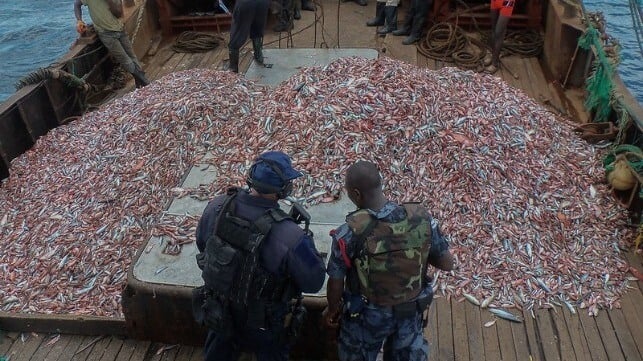Gulf of Guinea: What Kind of Cooperation in the Maritime Environment?

The world's major balances are changing rapidly as a result of changes in governments, regional tensions and fierce trade battles.
The great global institutions, the offspring of the last two world wars, are losing their credibility as the blocs decouple and the law of the strongest returns. Against this backdrop, it may be worth analysing these rapid changes and determining their current and future impact on the Gulf of Guinea and its neighbouring countries.
The center of global tensions is gradually shifting towards the Levant and the Indo-Pacific. World trade is and will remain mainly maritime, and the importance of the Straits has been brought home to us in recent months. New partners are extending their spheres of influence (China, Turkey, Russia, Brazil, etc.), while others with longer histories are reducing their footprints (UK, France, Spain, Portugal).
Crises and rising regional antagonisms are diverting military resources away from the Gulf of Guinea towards emerging areas of tension (Baltic Sea, Eastern Mediterranean, Red Sea and Gulf of Aden, Persian Gulf and Western Pacific).
The Yaounde architecture was built following the technical agreement of 6 May 2009. It was intended to be ambitious and to be based on existing structures (ECCAS/ECOWAS). In 2013, the Yaounde process initiated the construction of this interregional cooperation architecture based on an Interregional Coordination Centre (CIC Yaounde), two regional centres (CRESMAC & CRESMAO) and five multinational centers (MMCC A, D, E, F, G). The armed arm of the architecture, the CIC, was tasked with steering the joint maritime strategy between the various players in the zone, working on coordination, cooperation, interoperability and pooling.
The mission
The Yaounde Architecture (Y.A) was initially built around one main threat: maritime piracy.
While this threat was very prevalent around Nigeria and Cameroon, the epicenter of this criminal activity at the turn of the 2010/2020s, the peripheral states (countries in zones A, G & F) had very little to do with this problem.
This specific focus on maritime piracy led to a delay in the structuring and operational rallying of regional centers that were not, or were only marginally, involved (MMCC A, MMCC F, MMCC G). However, the coastal countries were faced with much wider threats in terms of type and impact (illegal fishing, illegal trafficking, pollution, etc).
The initial uniformity of the ‘Y.A. tool’ and the definition of initial missions and objectives thus slowed down the growth of this organization.
Resources
The Yaounde architecture must receive funding from the member countries to enable it to function properly. However, this initial agreement was never met, with economic crises affecting the majority of contributing countries.
These funding shortfalls have had a severe impact on the operation of the various centers due to a lack of material and human resources. Although significant progress has been made over the last 20 years, military maritime resources (ships, aircraft, personnel, intelligence resources) are still inadequate for the maritime areas to be controlled.
Coordination
Although there have been some notable successes in regional cooperation, coordination and cooperation are mainly affected by the general lack of resources. This cooperation is most effective in managing long-term crisis situations. It requires improvements in preventive cooperation and in post-incident management. However, this need is complex when it involves ships flying very different flags, international operators and crews, and transnational areas of activity.
Bilateral partnerships have been set up on top of the Yaounde architecture for the benefit of countries in the same Y.A. zone or even countries belonging to different Y.A. zones. National administrations have also established links between state, regional or interregional structures, following the example of Shared Awareness and Deconfliction (GoG-MCF/SHADE). Finally, the initial innovative initiatives set up in zone D (military vessels under TACON MMCC) have not been strengthened or replicated in other zones of the Yaounde architecture.
Cooperation
In view of these difficulties and the complexity of actions aimed at securing maritime areas, it is essential to determine the objectives to be pursued, the appropriate and financeable requirements needed to meet these objectives, and the mechanisms and timetables for implementation. This task is made all the more difficult by the fact that countries have more or less appropriate intelligence, deterrence and intervention resources at their disposal, that they face very different problems and threats, and that their internal resources are more or less constrained.
Numerous cooperation programs, whether financial, training, material or operational, are run by a wide range of partners: countries, unions of states and international organisations.
These programs, which sometimes run over several years, can occasionally ‘overwhelm’ the overall coherence expected at a national or regional level. Beneficiary countries may also be disoriented by the overlapping of disparate and incomplete procedures, concepts and resources, making it impossible to provide a simple, effective and coherent tool.
In 2023, ECCAS has convened a meeting in Kinshasa to redefine the strategic axes of the integrated policy for the seas and shared continental waters of ECCAS, as well as the strategy for the safety and security of vital interests at sea and in the shared continental waters of ECCAS Member States, thus marking the need to refresh and possibly reorientate regional policy in this area. This regional brainstorming should, in this context, probably involve two areas of reflection: first, on the primacy of initial interregional, regional or bilateral cooperation; and second, on the format, nature and points of application for this cooperation.
Francois Morizur is a maritime security expert.
The opinions expressed herein are the author's and not necessarily those of The Maritime Executive.
